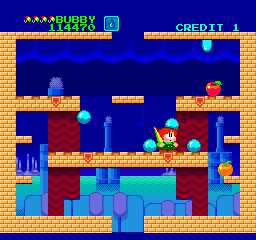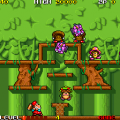Like its subtitle states, Taito’s Parasol Stars is a spinoff of Bubble Bobble, much like Rainbow Islands before it. You take on the role of Bubby and/or Bobby, here in human form, as they clear the screen of enemies, while gobbling up treats to score points. Rather than bubbles or rainbows, the chubby little heroes use their parasols to knock out the enemies. You can stun weaker foes by whacking them, which can then be juggled and tossed across the screen at other enemies. This is important, because stronger foes can’t be directly attacked, so you need toss at least a few other baddies at them before you can dispose of them. In some of these ways, it’s a little more like Don Doko Don, another similar platformer developed by Taito a few years prior. Unlike Bubble Bobble, many stages scroll horizontally back and forth, though they’re still quite small. Each stage is filled with hidden score items, many revealed by tossing things across the screen. With the umbrella extended, you can also float down slowly between platforms.
To aid this, many stages have elemental droplets of four different types that you can catch with your umbrella. When you catch five of them, they’ll form a large drop to shoot a stronger attack, depending on the element type, some of which will be familiar to Bubble Bobble fans – lightning will send an electric bolt across the screen, water will cause a flood that will splash downwards through the stage, fire will causes flames to ignite along the ground, and star will cause a spiral of stars to hit enemies across the screen. The most interesting stages involve using these elemental powers in clever ways, like sweeping yourself with a flood to squeeze through small cracks in the floor or dropping flames to attack enemies from above. All of the boss battles give you a jar that let you summon unlimited elemental attacks to make fighting them easier.
It wouldn’t be a Bubble Bobble game if there weren’t some arcane, unexplained mechanics at play. If you form two or more large drops, then a crest of the same elemental type will appear on the next stage. If you collect three of these crests of the same type, it’ll summon a Miracle, which can have a variety of effects for the next world – the Lightning Miracle, for example, spawns more screen-clearing cross power-ups, while the Fire Miracle causes fallen enemies to grant 10,000 point items. There’s also a hidden Rainbow Necklace that can grant 99 credits.
There are eight main planets, each consisting of six stages and a boss battle, beginning with the cheery Musical Star, continuing through to a foresty Wood Star, the Oceanic Star, a factory-like Machine Star, the casino-esqie Gambling Star, and finishing up on the Rainbow Star. If you progress normally, the game will end at the sixth world with a bad ending. However, you manage to spawn and collect three star icons and trigger a Star Miracle, you’ll get a key that lets you enter a secret door, taking you to the two final stages, the Bubble Star and the Underworld, featuring elements of Bubble Bobble (as well as a cameo from Doh, the Moai head boss of Arkanoid) and its spiritual predecessor, Chack ‘n Pop.
Parasol Stars is reasonably generous with lives and credits. The emphasis on short range parasol attacks means that you’re often put in danger a lot more than the bubble or rainbow attacks of its predecessors. This especially becomes more noticeable when you’re down to the last enemies on the stage and they begin quickly jumping around, making them harder to attack. Some later stages also get overwhelmed with enemies to the point that they’re hard to distinguish from the score items, particularly the tokens in the casino stage. But issues like these aside, it’s not too hard of a game, and fans of these types of single screen platformers will find a lot to like.
Unlike its predecessors, which originated as arcade games, Parasol Stars originated as a PC Engine/TurboGrafx-16 game, with the American version published by Working Designs. Visually, you probably wouldn’t be able to tell, because it has the same colorful backgrounds and wide-eyed characters. The sound is a little scratchy, typical of HuCard TurboGrafx-16 games. The main theme is catchy but it plays through most of the game and quickly becomes tiresome. The boss theme is a standout, even though it’s clearly inspired by (and perhaps legally infringing on) Koama’s 1989 song Lambada.
Ocean licensed the game and ported it to a few different platforms in Europe, renaming certain versions Parasol Stars: Rainbow Islands 2. The Amiga and Atari ST versions are the closest to the original. The color palette is darker so it ends up feeling strangely gloomy compared to its original, and the single button controls can be frustrating, but otherwise it plays pretty well. There’s even an extra exclusive bonus stage, unlocked near the end of the ocean stage, which sends you a different underworld-esque set of levels. The NES version is based on this version but with downgraded visuals, slower gameplay, and missing the extra world. The Game Boy version plays a little bit faster than either of these, with some minor quirks that make it a little more difficult. A Commodore 64 version was in development, but its work-in-progress was destroyed by the programmer’s soon-to-be-ex-wife.
Parasol Stars was resurrected by ININ games and Ratalaika in 2024 for the PS4/5 and Switch. Like many of their retro releases, it’s a pretty straightforward emulation, offering some niceties like fast forward and rewind functions. It also offers a control fix – in the original game, you always faced forward when holding out your parasol, but this option lets you change directions, allowing you to throw enemies behind you.
Links:
ZZap Raine – Port breakdown.
Games That Weren’t – Source for the Commodore 64 port story.
Thanks to ReyVGM for help to unlock the hidden worlds.


